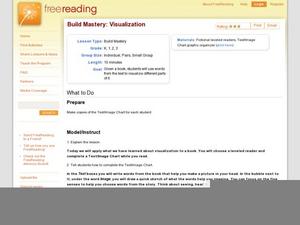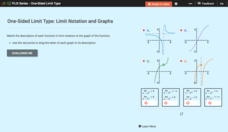Curated OER
Put The Numbers into Order
This presentation should provide good practice for youngsters who are just learning how to count larger numbers, and how to use a number line. In it, learners are given sets of four numbers. They use their computer mouse to click on the...
Curated OER
Find the Rhyme
Which one rhymes? There are four starting objects here, each heading a row of three objects. Learners identify the objects and their vowel sounds to determine which one rhymes with the first object. All these rhyming words involve the...
Curated OER
Find the Rhyme
Find the rhyming word. All of these rhyming, single-syllable words have the short i sound, but learners have to determine which ones they are. There are four starting objects each heading a row of three objects. They examine the three,...
Curated OER
The ai and ar Sounds
These words sound the same but are spelled differently, giving scholars a chance to practice spelling patterns and rhyming words. First they read that the /ai/ vowel sound can be made with three different spellings. Learners label three...
Curated OER
The ee and ie Sounds
Put to use the old saying, "When two vowels go a walking, the first one does the talking." Scholars focus on the /ee/ and /ie/ sounds and spelling patterns that create them. First, they label four pictures with the ea and ee spellings,...
Curated OER
Adding Up
Make addition visual in order to help beginners understand the concept. They add up beads on a string, examining an example before trying it on their own. Learners fill in addends and sums for these, and sometimes both. Although...
Curated OER
Counting by 3s, 4s, and 5s
Skip count along the mushrooms to complete these number sentences which give young scholars an introductory look at addition and subtraction. Starting from five double-digit numbers, they subtract or add by threes, fours, and fives to...
Curated OER
Everyday Problems
Bring math into the real world with these scenarios which have scholars adding and subtracting money and measurements. There are five word problems here. One involves three addends, another decimals, and another prompts learners to find...
Curated OER
Fact Families
With a few extra numbers, these fact families would be complete! After looking at an example, scholars write in the sums and differences for six equations as part of three different fact families. This is really for beginners to this...
Curated OER
Finding Patterns
What's the pattern? Learners skip count to complete 12 sequences, some of which increase and some of which decrease. As they solve each number pattern they count by 2, 3, 4, 5, 6, 10, and 100, getting some extra subtraction and addition...
Curated OER
Frogs Hopping by 2s
Hop to it! Beginning counters fill in water lily number sequences as a frog "hops" across them, skip counting by twos. There are five sequences in total, and some require counting backward. Learners can reference the two examples, which...
Curated OER
Identifying Patterns
Although this fractions exercise may seem difficult at first, it's really quite simple and intended for beginners to mixed numbers. Scholars complete 15 number sequences by adding two or three mixed numbers or decimal numbers. However,...
Curated OER
Identifying Patterns
Explore number attributes and skip counting through patterns! Scholars find the pattern in each of these sequences and continue it by writing in the remaining values. They count consistently by various intervals, sometimes forwards and...
DK Publishing
Sliding Snails: Count by 10s
Even snails can move quickly when working through this assignment! Youngsters match written number words to their numerals (ten to 10, for example), and then decipher what numbers are covered by snail slime in a number sequnce. All of...
Curated OER
Working with 10s and 1s
Can your first graders count by 1s? What about by 10s? Use this graphic learning exercise to help youngsters visualize place value and counting. They count how many sets of 1s or 10s they see, then they draw a given number of 1s or 10s....
Alabama Department of Archives and History
Two Different African-American Visions: W.E.B. Du Bois and Booker T. Washington
The strategies civil rights activists Booker T. Washington and W.E.B. Du Bois proposed for blacks to achieve racial progress is the focus of an activity in which class groups identify the strategies as well as the benefits and drawbacks...
Illustrative Mathematics
Assessing Sequencing Numbers
Assess whether your kindergartners can identify numbers in random order using two sets of numeral cards 1-10 and 11-20. Starting with a small group and the 1-10 deck give your learners the task of putting the cards into order from...
CK-12 Foundation
One-Sided Limit Type: One-Sided Limits
Not everything that's one-sided is bad. A slider interactive aids learners in investigating one-sided limits from graphs. A set of challenge questions assesses their understanding of the relationship between one- and two-sided limits.
Curated OER
Hopping by 2s, part 2
Explore skip counting by twos with young mathematicians as they complete these engaging activities. First, they color in squares to represent counting by twos in an even sequence and an odd sequence. Next, they connect dots (by twos) to...
Curated OER
Are You Aware?
Bring the five senses to life with a fun science experiment! Kindergartners and first graders read an explanation of the five senses, then identify which items Sophia can sense if she is blindfolded. A science explanation at the bottom...
Curated OER
Build Mastery: Visualization
What do you see? Young reader tap into the visualization process as they listen to or read a fiction story and fill out a graphic organizer. Model this first with a think-aloud, showing scholars how you visualize a familiar story. For...
Illustrative Mathematics
Fixing the Furnace
This comprehensive resource applies simultaneous equations to a real-life problem. Though the commentary starts with a graph, some home consumers may choose to begin with a table. A graph does aid learners to visualize the shift of one...
Lorain County Community College
Solving Linear Equations in One Variable
Multiple-step problems don't have to equal tough problems. This worksheet provides a list of steps needed to go through multi-step equations that include combining like terms and distributing. With ten problems total, your learners will...
CK-12 Foundation
One-Sided Limit Type: Limit Notation and Graphs
A one-sided limit is no less important than a two-sided limit. Young mathematicians use an interactive to match limit notation to graphs. The exercise requires interpreting how one-sided limits connect to features of graphs.
Other popular searches
- Numbers
- Five Senses
- Prime Numbers
- Base Ten Blocks
- Five Themes of Geography
- Prime Factorization
- Three Branches of Government
- Ordinal Numbers
- Rounding Numbers
- Number Sense
- Mixed Numbers
- Number the Stars

























